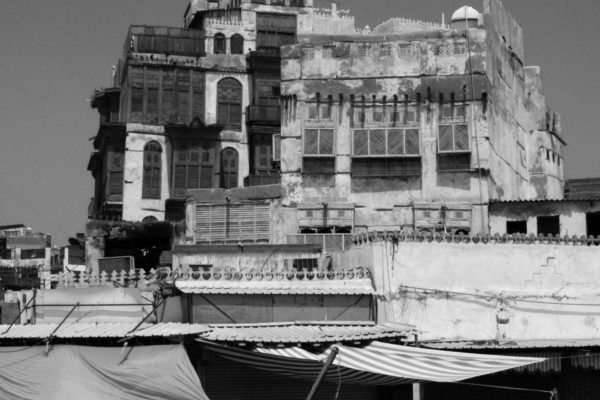(originally published in Architecture Today for the “My Kind of Town” column and in Destination Jeddah)
I could never claim that Jeddah is my kind of town. Saudi Arabia’s city of the Red Sea, like no other city I’ve visited before, continuously makes it clear – perhaps deliberately – that it’s not about me nor for that matter anything that might be connected to me. Not only do I get the message that the city barely suffers my presence, but it also parades before me roads, systems, countries, worlds that operate outside my assumptions. Jeddah is a nodal point of a world greater than mine. For centuries Jeddah has been the sanctioned harbour of Makkah (Mecca) and the region’s other holy cities – approached by some of Jeddah’s roads physically closed to me. Jeddah maintains an ineradicable position as a port-of-call for millions of people who visit Makkah every year – from the Sahel region of Africa, Bangladeshi estuaries, Pacific isles, the Tajikistani mountains and hundreds of other places that exist only as commanding places in my imagination. I’ve come closest to these people in the streets and hallways of Jeddah – some of them descend from people who came on pilgrimage hundreds of years ago and never left; others are in my ramshackle hotel’s lobby, restoring their energy before embarking on the rough road to Makkah.
Jeddah’s connection to Islam’s core not only secures it a pivotal role in the religious map of Islam; it also embodies a logical extension to Makkah’s other historical function (starting well before Mohammed’s birth) – a trade hub. A friend tells me of his mother’s annual lone trip to Jeddah. She would board a plane almost empty-handed in Damascus and land in Jeddah, perform the Umrah over a few days and then use all of her baggage allowance plus more to haul fabrics, lace, buttons and yarns back to Damascus to fill her stock room. Mohammad was a tradesman, and so are female shop owners in Syria. I started to understand Jeddah working on the publication Al Manakh 2: Gulf Continued. The book was a follow-up to the 2007 Al Manakh which considered the conditions of Gulf cities. For the second one, we had decided to cover Saudi Arabia. Jeddah, of course, is not an Arabian Gulf city, it is the ‘bride of the Red Sea’, and its people (if they are not from somewhere else) are proudly Hejazi. But you can’t begin to characterise Saudi cities without considering Jeddah. At the same time, once you place Jeddah into comparisons, all generalisations fall apart.
Although they may not be entirely reliable, Gulf cities present clear narratives, or visions. Even for the most sceptical of observers, renderings of ambitions for future financial centres and residential neighbourhoods in Abu Dhabi or Doha manage to command at least a moment’s suspension of disbelief. In Jeddah, such romantic bouts of profit promises simply fade from existence. Dubai, Doha, Abu Dhabi – they all announce themselves with the persuasive crispness of a corporate annual report. Gulf cities proclaim goals and benchmarks and deliver charts, figures, models, renderings, and CNN commercials to make it clear where they aim to go. Gulf cities show themselves on course, like true students of modernism. They make themselves out to be moving linearly. Jeddah, however, defies the linear.
When one listens to Jeddans talk about their city, it can be difficult to discern if they are telling you something they find funny or utterly tragic. It’s neither and both, or maybe an entirely different category that doesn’t exist in my language. Ziad Aazam, an architect in Jeddah, described it for me in words that also landed in his piece for Al Manakh: ‘Jeddah defies logic and inflicts pain yet communicates to the hearts of its inhabitants and visitors meanings of love and belonging.’ Jeddah is emotions that swarm around you, making you elated and incoherent, then overwhelmed with exhaustion.
One of the city’s most optimistic moments in decades was the 2009 publication of the Jeddah Strategic Plan, the most recent attempt to bring order to a city that responds more to whim than to will. In language that was somehow sweet and stinging, most people I talked to about Jeddah’s new ‘roadmap’ held some hope that the plan would provide a stable rock to hold onto. Then came the November floods. Hundreds of people were killed, brutally exposing parts of a city that were living on the sham of an infrastructural system. Submerged highways were vast vestibules of rainwater. Homes collapsed as if made of plaster, and roads surrendered to avalanches of red clay earth. For a moment there was optimism – that this would be the turning point; that Jeddah’s leaders would have no option but to give some order to the chaos. Fierce optimism found its way into a moment of despair. As the rainwater dissipated and government officials made at least ostensible attempts at finding those to blame, the Jeddans I know started to settle back into that indefinable talk that settles somewhere between laughter and exasperation, but always with a warm hand for the man who doesn’t belong.
